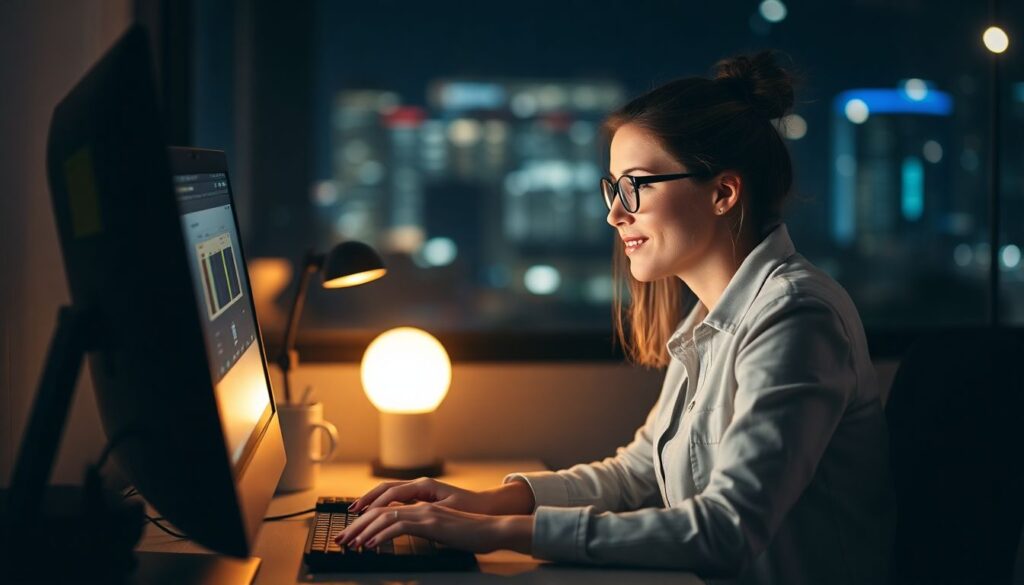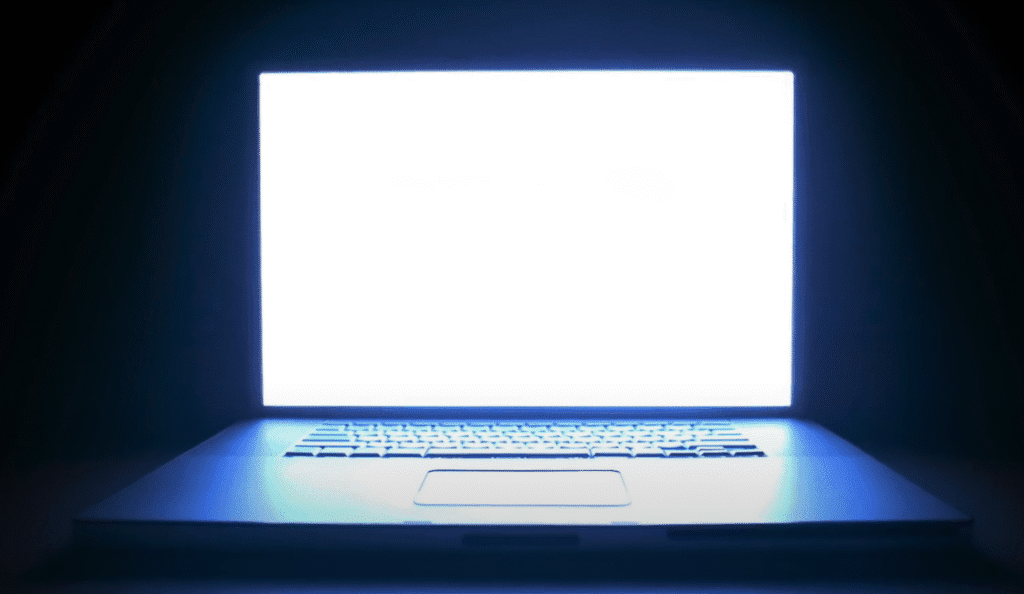How Blue Light Affects Sleep and What to Do About It
Blue light exposure from screens and artificial lighting significantly impacts sleep quality and circadian rhythm regulation. This article takes a look closer look at how artificial blue light affects your sleep patterns and provides evidence-based strategies for better rest.
For protect the quality of your sleep, consider investing in quality blue light blocking glasses to filter harmful wavelengths before bedtime.

What Is Blue Light and Where Does It Come From?
Blue light represents high-energy, short-wavelength light within the visible spectrum, measuring approximately 380-500 nanometers. Natural sunlight serves as our primary blue light source, while artificial sources include:
- LED and fluorescent lighting systems
- Digital screens (smartphones, tablets, computers, televisions)
- Electronic reading devices
- Modern automotive headlights
Our circadian rhythm—the internal biological clock controlling sleep-wake cycles—evolved to respond to natural light patterns. Blue wavelengths signal daytime alertness, while their absence triggers nighttime sleepiness.
The Science of Blue Light Sleep Disruption
Understanding how blue wavelengths affect sleep requires examining specialized retinal cells called intrinsically photosensitive retinal ganglion cells (ipRGCs). These photoreceptors demonstrate particular sensitivity to blue spectrum light and regulate non-visual responses including circadian timing.
When blue wavelengths activate ipRGCs, they initiate this biological cascade:
- The suprachiasmatic nucleus (SCN)—your brain’s master clock—receives light signals
- The SCN communicates with the pineal gland
- The pineal gland controls melatonin production—the primary sleep hormone
During daylight hours, blue light exposure maintains alertness and cognitive performance. As evening approaches, reduced blue light exposure allows natural melatonin production, preparing your body for sleep.
Evening artificial light exposure disrupts this natural rhythm, tricking your brain into maintaining daytime alertness.
How Evening Blue Light Exposure Harms Sleep Quality

Nighttime blue wavelength exposure causes multiple sleep disruptions:
- Melatonin Suppression: Evening blue light exposure reduces melatonin production which can lead to delayed sleep onset.
- Extended Sleep Latency: The time required to fall asleep increases substantially. This proves particularly problematic for individuals already experiencing insomnia or sleep difficulties.
- Reduced REM Sleep: Blue light exposure diminishes rapid eye movement sleep—the crucial stage associated with memory consolidation and emotional processing. REM sleep reduction affects cognitive function and emotional regulation. For additional support in achieving deeper REM sleep, consider exploring natural supplements for better sleep quality.
- Compromised Sleep Architecture: Overall sleep quality suffers even when you manage to fall asleep. This results in frequent nighttime awakenings and reduced restorative deep sleep stages.
- Daytime Fatigue: Poor sleep quality leads to increased daytime drowsiness and decreased cognitive performance, affecting work productivity, academic achievement, and safety activities like driving.
- Circadian Rhythm Disruption: Chronic evening blue light exposure misaligns your internal clock with environmental cues, potentially contributing to metabolic disorders, cardiovascular issues, and mood disturbances.
Understanding Melanopsin and Blue Light Sensitivity
Melanopsin, a specialized photopigment within ipRGCs, drives blue light sensitivity. Unlike standard vision cells (rods and cones), melanopsin-containing cells primarily regulate non-visual light responses, including circadian rhythm control.
Melanopsin demonstrates peak sensitivity around 480 nanometers—directly within the blue-green spectrum. This explains why blue wavelengths exert such powerful effects on sleep-wake cycles.
Melanopsin activation triggers signaling cascades that suppress melatonin production. Even relatively low blue light levels can significantly impact sleep patterns, making spectral composition more important than light intensity alone.
Proven Strategies to Minimize Blue Light Sleep Disruption
Digital Device Management
- Implement Screen Curfews: Avoid digital devices 1-2 hours before bedtime, allowing natural melatonin production to increase.
- Activate Built-in Filters: Enable “night mode” or “night shift” settings on devices, which reduce blue light emission by shifting color temperature toward warmer tones.
- Install Blue Light Software: Programs like f.lux automatically adjust screen color temperature based on time, gradually shifting displays to warmer colors as evening approaches.
Lighting Optimization
- Choose Warm Evening Lighting: Use bulbs with lower color temperatures (around 2700K) for warm, amber-toned light that minimizes circadian disruption.
- Dim Lights Progressively: Gradually reduce lighting intensity as bedtime approaches, mimicking natural sunset patterns.
- Install Smart Lighting Systems: Automated lighting that adjusts color temperature throughout the day supports natural circadian rhythms.
Blue Light Blocking Solutions
- Invest in Quality Blue Light Glasses: Specialized eyewear filtering 450-495 nanometer wavelengths provides effective protection when evening device use is necessary. See our top amber blue light blocking glasses in this review.
- Use Screen Protectors: Blue light filtering screen protectors offer additional protection for frequently used devices.
Sleep Environment Optimization
- Create Complete Darkness: Use blackout curtains, eye masks, and eliminate LED indicators from electronics to minimize light exposure during sleep.
- Increase Daytime Light Exposure: Maximize natural light exposure, especially morning sunlight, to reinforce healthy circadian rhythms.
- Maintain Consistent Sleep Schedules: Regular sleep and wake times support circadian rhythm stability regardless of light exposure.
Individual Differences in Blue Light Sensitivity
Personal chronotypes—natural tendencies toward “morning lark” or “night owl” patterns—influence blue light sensitivity. Research suggests night owls may show greater resilience to evening blue light effects, while morning larks demonstrate increased sensitivity.
These differences likely stem from variations in clock gene expression and circadian system responsiveness to light signals. However, regardless of chronotype, mindful blue light management benefits all individuals.
Blue Light Effects on Sleep Architecture
Blue wavelength exposure affects not only sleep timing but also sleep structure throughout the night. Sleep architecture refers to the pattern of sleep stages including light sleep, deep sleep, and REM sleep.
Research demonstrates that pre-bedtime blue light exposure alters sleep architecture through:
- Reduced Slow-Wave Sleep: Deep sleep stages crucial for physical restoration and memory consolidation decrease with blue light exposure.
- Delayed REM Sleep: Important cognitive and emotional processing sleep stages occur later in the cycle, potentially reducing overall REM duration.
- Increased Sleep Fragmentation: More frequent nighttime awakenings result in less continuous, restorative sleep.
- Extended Sleep Onset: Longer time to fall asleep reduces total sleep duration and quality.
These architectural changes significantly impact daytime functioning, including cognitive performance, mood regulation, and energy levels.
Blue Light and Sleep Disorders
Increasing environmental blue light exposure correlates with rising sleep disorder prevalence. While not the sole cause, blue light can exacerbate existing conditions and contribute to new issues:
Insomnia: Evening blue light worsens difficulty falling asleep or maintaining sleep by delaying sleep onset and disrupting sleep continuity.
Delayed Sleep Phase Syndrome: This circadian rhythm disorder involves persistent sleep-wake cycle delays. Evening blue light exposure can reinforce and worsen delayed sleep patterns.
Shift Work Sleep Disorder: Night shift workers face additional challenges when blue light exposure during work hours further disrupts daytime sleep ability.
Jet Lag: While primarily caused by time zone changes, blue light exposure at inappropriate times relative to new schedules can worsen jet lag symptoms.
Understanding these relationships helps develop comprehensive treatment approaches that include blue light management as a key component.
Blue Light and Eye Health Considerations
Beyond sleep effects, blue light exposure raises eye health concerns. The human eye provides limited blue light filtering, allowing most wavelengths to reach the retina.
Prolonged blue light exposure, particularly from digital devices, associates with several vision-related issues:
Digital Eye Strain: Extended screen use causes eye fatigue, dryness, headaches, and blurred vision—collectively known as Computer Vision Syndrome.
Potential Retinal Damage: Some research suggests long-term high-energy blue light exposure might cause photochemical retinal damage, though more studies are needed.
Age-Related Concerns: Ongoing research investigates potential links between blue light exposure and macular degeneration or cataract development.
Protective measures include following the 20-20-20 rule (every 20 minutes, look at something 20 feet away for 20 seconds), adjusting device brightness, using artificial tears for dry eyes, and maintaining regular eye examinations.
Improve Your Sleep Quality by Managing Blue Light Exposure
Blue light helps regulate your body’s natural sleep-wake cycle, but too much of it at night can make it harder to fall asleep and lower sleep quality. Screens and LED lights are major sources of this artificial blue light.
To protect your sleep, it’s important to combine a few smart habits: set limits on screen time before bed, use blue light blocking glasses or screen filters, choose softer bedroom lighting, and stick to a regular sleep schedule.
Everyone reacts differently to blue light, but research shows that reducing exposure in the evening can lead to better sleep.
Good sleep isn’t just about what you do at night—it also depends on your light exposure during the day. Aim for bright, natural light in the morning and early afternoon, and limit harsh blue light in the hours before bedtime.
Frequently Asked Questions About Blue Light and Sleep
Does blue light affect sleep quality?
Yes, blue light significantly affects sleep quality by suppressing melatonin production and disrupting your natural circadian rhythm. Evening exposure to blue light from screens and artificial lighting can delay sleep onset, reduce time spent in deep sleep stages, and cause more frequent nighttime awakenings, resulting in poor overall sleep quality and daytime fatigue.
What wavelengths define blue light?
Blue light consists of wavelengths between 380-500 nanometers on the visible light spectrum. The most disruptive wavelengths for sleep are between 446-477 nanometers, which correspond to the blue light emitted by most LED screens, smartphones, tablets, and modern lighting systems.
How long before bed should you stop looking at blue light?
You should stop looking at blue light sources 1-2 hours before bedtime to optimize sleep quality. This timeframe allows your body to naturally increase melatonin production and prepare for sleep. If you must use devices closer to bedtime, use blue light filters or blocking glasses to minimize disruption.
What color light helps you sleep?
Warm, amber-colored light with temperatures around 2700K helps promote better sleep. Red and orange wavelengths have minimal impact on melatonin production, making them ideal for evening use. Avoid cool white or blue-tinted lights in the hours before bedtime as these suppress natural sleep hormones.
What are the symptoms of too much blue light?
Symptoms of excessive blue light exposure include difficulty falling asleep, frequent nighttime awakenings, daytime fatigue, eye strain, headaches, dry eyes, and mood changes. You may also experience delayed sleep onset, reduced sleep quality, and feeling unrefreshed upon waking even after adequate sleep duration.
Does dark mode reduce blue light?
Dark mode provides some blue light reduction by displaying less bright white light, but it doesn’t eliminate blue light entirely. While dark mode can reduce eye strain and overall light exposure, it’s not a complete solution for blue light protection. For optimal results, combine dark mode with dedicated blue light filters or blocking glasses.
Does TV emit blue light?
Yes, modern televisions emit significant amounts of blue light, especially LED and OLED displays. The larger screen size means greater overall blue light exposure compared to smaller devices. Watching TV in the evening can disrupt your sleep cycle, so consider using blue light filters, reducing brightness, or avoiding TV 1-2 hours before bedtime.
Do cell phones give off blue light?
Cell phones emit substantial amounts of blue light through their LED screens, making them one of the most common sources of evening blue light exposure. The close proximity to your eyes during use intensifies the exposure. Using night mode settings, blue light filtering apps, or avoiding phone use before bedtime can help minimize sleep disruption.
